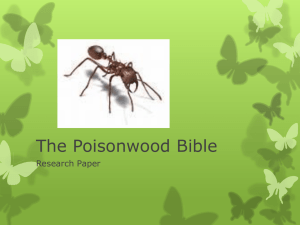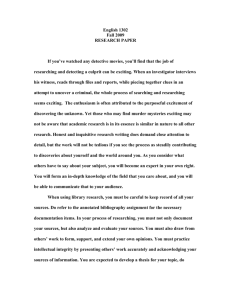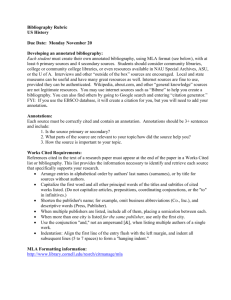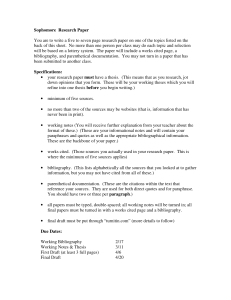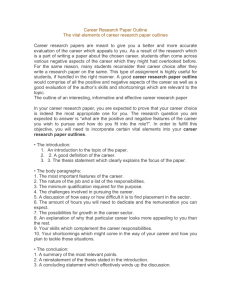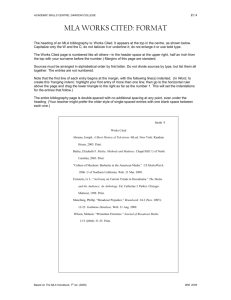The research paper - Mrs-Wilmarths-Wiki
advertisement
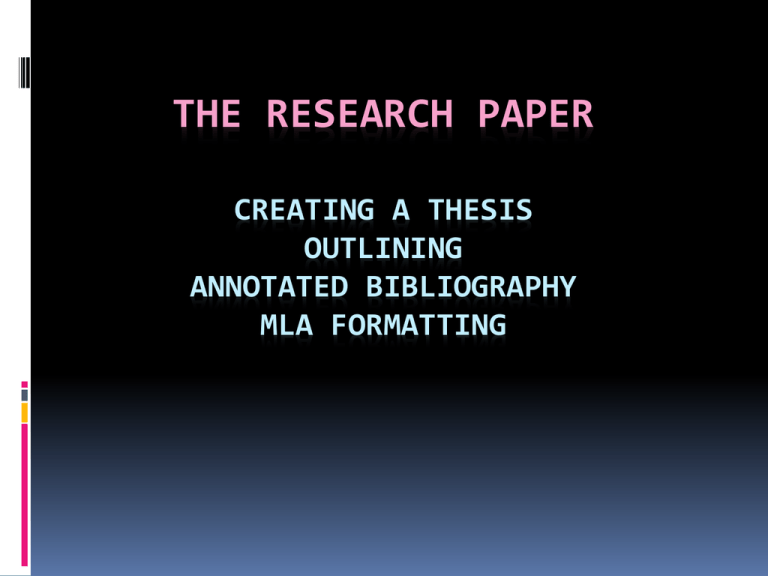
THE RESEARCH PAPER CREATING A THESIS OUTLINING ANNOTATED BIBLIOGRAPHY MLA FORMATTING CHOOSING A TOPIC Although you should have chosen and presented a possible topic of your research paper last year on your Plan of Action, while beginning to research, you may have discovered that your topic is not arguable, does not have ample/reliable sources, or it is too narrow or too broad. Because of this, you may have to modify your topic, but remember, it must relate to your shadowing experience. CREATING A THESIS STATEMENT A Thesis is a single, concise, grammatically correct sentence that presents the argument that you prove in your research paper. This sentence should be declarative and in the third person, active voice. The thesis should clearly present your point of view, and usually appears as the last or second to last sentence in the first paragraph. Use a Because Statement to create your thesis. For example: Because of growing fears of global warming, the government should implement mandatory recycling program in all of its offices. CHOOSING SOURCES Your research paper should be 4-6 pages if you are in the Honors or General classes, and 2-5 pages if you are in the nonlanguage class. You will need to choose relevant and credible sources to help you prove your thesis. The honors and general classes use at least 6 sources 1 primary source -an interview or survey 2 Internet sources -from a .edu, .gov, .mil, or .us OR a preapproved .com, .net, or .org *never an editable website 3 written sources -scholarly journals, books, or newspapers. *no reference books Students in the non-language class use at least 1 source from each category. 1 primary source -an interview or survey 1 Internet source -from a .edu, .gov, .mil, or .us OR a preapproved .com, .net, or .org *never an editable website 1 written source -scholarly journals, books, or newspapers. *no reference books ANNOTATED BIBLIOGRAPHY An annotated bibliography is an MLA formatted citation, followed by a brief description/evaluation of the source (about 150 words; 4-6 clear concise sentences.) The annotation should inform the reader of the source’s relevance, accuracy, & quality. The annotation should include the following: The main focus/ a summary of the source The worth, effectiveness, usefulness, and relevance of the source to your topic A verification/critique of the authority, credibility, or qualifications of the source’s author Conclusions/observations reached by the author and/or reader Please remember that these are sources that you plan to use in your paper. How to set up your Annotated Bibliography & Works Cited page The title of each page should be centered without italics, underlines, or quotations. The annotation begins on a separate line than the citation. The citations and annotations are indented after the first line. Before going to a second line, fill the first to the margin. As on the Works Cited page, all citations should appear on the Annotated Bibliography in alphabetical order by author’s last name. Like a sentence, every citation ends with a period. Remember, like all MLA documents, the Annotated Bibliography should be double spaced and in 12 point Times New Roman font. It should also have 1 inch margins. When writing your annotated Bibliography, formal writing must be used. For example, use 3rd person without slang or abbreviations . How to Cite on your Works Cited page & Annotated Bibliography Basic formula to citing in MLA format Author’s last name, author’s first name. Title. City where the work was published: Publisher, year published. Title Author Publishing information Smith, Mary. The Truth in Lying. Chicago: Putmun, 1999. Year published (most recent) Comma Author’s first name Author’s last name Underlined Title of work City where work was published Publishing company Citing format and examples Book with one author Author’s last name, author’s first name. Title. City where the work was published: Publisher, year published. Keating, James. Building a Future Today. NewYork: HarperCollins, 1992. Book with 2-3 authors 1st Author’s last name, author’s first name,2nd author’s first name, last name, 3rd author’s first name, last name. Title. City where the work was published: Publisher, year published. Hutts, Kenneth, James Harper, Ben Jameson. Reading for Today. Cambridge: Harvard College, 2003. Book with 4+ authors 1st Author’s last name, author’s first name, et al. Title. City where the work was published: Publisher, year published. James, Kate, et al. Technology in the Classroom. NewYork: HarperCollins, 1998. Book with editor without author Editor’s last name, Editor’s first name, Ed. Title. City where the work was published: Publisher, year published. Thomas, Susan, Ed. The Book of the Future. Philadelphia: HarperCollins, 2000. Book with author and editor Author’s last name, author’s first name. Title. Ed. Editor’s first name editor’s last name. City where the work was published: Publisher, year published. Genner, Gerald. Cities with Crime. Ed. Carry Early. New York: Putnum, 2002. Pamphlet (published by an organization) Author’s last name, author’s first name. Title. City where the work was published: Organization, year published. Bates, Jason. Technology in Medicine. Scranton: Mercy Hospital, 1998. Corporation or Organization as author Company Name. Title. City where the work was published: Publisher, year published. Modern Language Association. Writing a Good Paper. New York: Educational Books, 1998. Survey Surveyor’s last name, first name. “Title of survey.” Survey. City where it was given: Location, year published. Thompson, Lindsey.”Research Methods.” Survey. Dunmore: Marywood University, 2009. Book with multiple editions Author’s last name, Author’s first name. Title. #th ed. City where the work was published: Publisher, year published. Bennett, Claire. Learning by Trial and Error. 4th ed. Tuscan: HarperCollins, 2000. Interview Person interviewed’s last name, first name. Mode of interview. Date interviewed. Mataloni, Patricia. Telephone Interview. 21 September, 2009. Magazine Author’s last name, Author’s first name. “Name of article.” Name of Publication. Date of issue: Pages. Stevens, Lauren.”Researching the Past.” Teaching Pre-k through 6. September 2007: 19-23. Journal Author’s last name, Author’s first name.”Title of article.” Name of Journal. Issue/volume number (Date published) : Pages. DeSota, Gary. “Using advertisements in your Favor.” Professional Quarterly. 11 (Spring 1999): 2000-2031. Newspaper article Author’s last name, Author’s first name. “Title of article.” Name of Newspaper. Date published: Section Page. Brown, Andrea.”Schools for the Children.” New York Times. 23 September 2007: D 19. Anthology Author’s last name, Author’s first name. “Name of entry.” Book Title. Ed. Editor’s first name editor’s last name. City where book was published: Publisher, year published. Dramm, Robert.”Classroom Stories.” A Teacher’s Anthology. Ed. Brian Varvas. Los Angeles: Thompson, 2004. Introduction/Preface/Afterword Author’s of the introduction last name, first name. Introduction. Title. By Author of the book’s first name last name. City where it was published: Publisher, year published. Sohns, George. Introduction. Working for Today. By Stanley Burger. Pittsburg: Penguin, 1998. Book with translator Author’s last name, Author’s first name. Title. Trans. Translator’s first name last name. City published: Publisher, Year published. Jones, Andrea. Learning in the Workforce. Trans . Tina Edwards. Atlanta: World Books, 2003. Internet site Author’s last name, Author’s first name. “Title of article.” Ed. Editor’s first name last name. Date site was updates/copyrighted. Name of sponsoring website. Date the information was retrieved by researcher <full URL>. Burke, Jennifer.”Schooling for the future.” Ed. Tyler Simpson. August 2007. Susquehanna University. 2 October 2009 <http://www.susqu.edu/education/article/future>. Internet site with editor (no author) Editor’s last name, Editor’s first name, Ed. “Title of article.”. Date site was updates/copyrighted. Name of sponsoring website. Date the information was retrieved by researcher <full URL>. Smith, Sarah.”My Career as a Pilot.” 2007. United States Air Force. 22 October 2009 <http://www.airforce.mil/careers/benefits>. Internet site - no author or editor “Title of article.” Date site was updates/copyrighted. Name of sponsoring website. Date the information was retrieved by researcher <full URL>. “Your Money, Your Education.” 17 August 2007. United States Treasury Department. 3 September 2009 <http://www.loans.gov/college>. Notice that all lines after the first are indented. EXAMPLE Citation Focus of Source Relation to my topic Smith, Mary. The Truth in Lying. Chicago: Putmun, 1999. Smith’s book focused on a study that evaluated the reactions of adolescents faced with the decision to lie or to tell the truth. This book supports the concept of the relationship between lying to a child & his/ her recognition of the benefits of lying for self preservation. Also, the study shows despite a child’s lack of life experience, he/she still knows that lying goes against acceptable behavior. Ms. Smith has a Doctorate in Child Psychology and is a Professor at Brown University. Interestingly enough, these traits appear in children as young as eighteen months of age. Author’s authority/credibility Observations OUTLINING: THE PROPOSAL The proposal consists of the thesis and the outline of your paper. The outline is a way to organize your thoughts for your paper, so you should follow your basic outline when writing your research paper. When creating your outline, the first and last Roman numeral will be “Introduction” and “Conclusion.” Please remember you must have at least two elements to break down a topic (if you have a 1, you must have a 2) Remember we are making a topic outline, not a sentence outline. MLA FORMAT Modern Language Association Writing your research paper Formatting An MLA formatted paper is in 12 point times new roman font. Everything, including the heading, is double spaced. The margins are one inch and the header is ½ inch from the top of the page on the right side. The header includes your last name and the page number (no punctuation.) The heading, which appears on the left side, includes your name, the teacher’s name, the class, and the date (day month year.) The title is centered (not underlined, in quotations, or italicized) Paraphrase Verse Direct Quote **We always cite both!! Paraphrasing is when you take information from a source and put it all into your own words. With quoting, you take information from a source and use it word for word in your paper. If you use a direct quote, you must put the source’s words in quotation marks. Whether you are paraphrasing a source’s information or using it word for word, you must cite the source parenthetically in the text and on the Works Cited page. Citing in text (parenthetically) Remember if you are using another person’s words or ideas, you must give him/her credit by citing the work parenthetically in the text and on the Works Cited page. Whether you are using a direct quote, word for word, or paraphrasing, putting the sources ideas in your own words, you must cite! When citing in text, the author’s last name and page number should be in parentheses following the paraphrased or quoted information. To avoid plagiarism, it is important to distinguish your analysis from your source’s information. To avoid confusion, introduce the source’s name and authority, give the information, and then add the parenthetical citation. If you introduce the source’s name before giving his/her information, you only put the page number in the parentheses. Examples of Parenthetical Citations The following are examples of three ways to cite the same information. Notice all give credit to the author and provide the page number where the information came from. “It has been evident to this committee that the guilty verdict passed down from the lower court will be upheld” (George 234). Despite the evidence presented by the defense attorney, the New Jersey Supreme Court decided to agree with the district court. Because of this, Kennedy was once again declared guilty (George 234). According to Herman George, the author of A Man of Guilt, both the District and Supreme Courts decided the evidence against him was sufficient, so he was convicted on all charges (234). Works Cited Page The Works Cited page is the last page of your research paper. The font is still Times New Roman point 12, everything is double spaced, and margins are still one inch on all sides. Since it is a part of your research paper, a new heading is not included on the Works Cited page, and the page numbers (in the header) continue from the prior page. Entries are not separated according to whether they are primary or secondary, and they are not numbered or bulleted. All sources are cited in alphabetical order by the author’s last name. If there is no author, an entry is alphabetized by its title. Citations are in the same format as on the Annotated Bibliography (refer back to entry notes). Before handing in your paper… Use the checklist below to make sure your paper has been properly reviewed & prepared for submission Do you have MLA format heading and header? Do you have a catchy title? Do you have an attention getter? Do you have a clearly and concisely stated thesis? Did you use the most accurate and descriptive words possible? Did you conserve words by eliminating unnecessary empty or filler words? Does each of your body paragraphs have ONE main idea that supports the thesis? Did you analyze each point explaining why/how it supports the thesis? Did you give credit to each source PROPERLY, so you do not get accused of plagiarism? Is your paper in one tense (past)? Did you avoid using first person (I, me, our, mine, my) and second person (you, your)? Did you avoid contractions, abbreviations, and other language inappropriate for an academic research paper such as “this paper will” or “in this paper”? Did you avoid using “There,” Which is a pronoun with no antecedent? Do you have a Works Cited page with all of your sources cited correctly in alphabetical order? Is your paper the proper length? 2-4 full pages for 2nd period and 4-6 full pages for all other periods? Did you proof read your paper to make sure there are no grammatical, capitalization, or punctuation mistakes?
